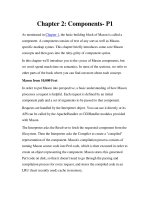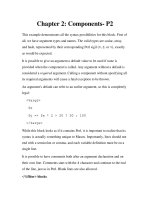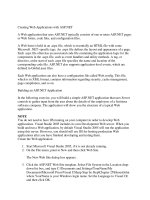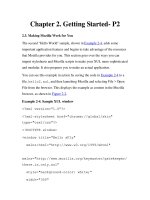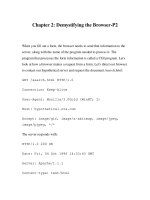creating mobile apps with sencha touch 2
Bạn đang xem bản rút gọn của tài liệu. Xem và tải ngay bản đầy đủ của tài liệu tại đây (23 MB, 348 trang )
www.it-ebooks.info
Creating Mobile Apps with
Sencha Touch 2
Learn to use the Sencha Touch programming
language and expand your skills by building
10 unique applications
John Earl Clark
Bryan P. Johnson
BIRMINGHAM - MUMBAI
www.it-ebooks.info
Creating Mobile Apps with Sencha Touch 2
Copyright © 2013 Packt Publishing
All rights reserved. No part of this book may be reproduced, stored in a retrieval
system, or transmitted in any form or by any means, without the prior written
permission of the publisher, except in the case of brief quotations embedded in
critical articles or reviews.
Every effort has been made in the preparation of this book to ensure the accuracy
of the information presented. However, the information contained in this book is
sold without warranty, either express or implied. Neither the authors, nor Packt
Publishing, and its dealers and distributors will be held liable for any damages
caused or alleged to be caused directly or indirectly by this book.
Packt Publishing has endeavored to provide trademark information about all of the
companies and products mentioned in this book by the appropriate use of capitals.
However, Packt Publishing cannot guarantee the accuracy of this information.
First published: April 2013
Production Reference: 1280313
Published by Packt Publishing Ltd.
Livery Place
35 Livery Street
Birmingham B3 2PB, UK.
ISBN 978-1-84951-890-1
www.packtpub.com
Cover Image by Avishek Roy ()
www.it-ebooks.info
Credits
Authors
John Earl Clark
Bryan P. Johnson
Reviewer
Kristian Kristensen
Acquisition Editor
Usha Iyer
Lead Technical Editor
Sweny Sukumaran
Technical Editors
Jalasha D'costa
Saumya Kunder
Project Coordinator
Amey Sawant
Proofreaders
Maria Gould
Kate Robinson
Indexer
Tejal Soni
Graphics
Ronak Dhruv
Production Coordinators
Manu Joseph
Nilesh Mohite
Nitesh Thakur
Cover Work
Nitesh Thakur
www.it-ebooks.info
About the Authors
John Earl Clark holds a Master's degree in Human Computer Interaction
from Georgia Tech and an undergraduate degree in Music Engineering from
Georgia State University. John and his co-author, Bryan P. Johnson, worked
together at MindSpring and later EarthLink, starting out in technical support
and documentation, before moving into application development, and nally
management of a small development team. After leaving EarthLink in 2002,
John began working independently as a consultant and programmer, before
starting Twelve Foot Guru, LLC with Bryan in 2005.
John has been working with Sencha Touch since the rst early beta releases.
He has also worked with Sencha's ExtJS since the early days when it was still
known as YUI-Ext. John has also written a previous book with Bryan Johnson
called Sencha Touch Mobile JavaScript Framework by Packt Publishing.
When he is not buried in code, John spends his time woodworking, playing the
guitar, and brewing his own beer.
I would like to thank my family for all of their love and support.
I would also like to thank Bryan for his help, his patience, and his
continued faith in our efforts.
www.it-ebooks.info
Bryan P. Johnson is a graduate of the University of Georgia. Bryan went on to work
for MindSpring Enterprises in late 1995, where he met his co-author John Clark.
At MindSpring, and later EarthLink, for over seven years, Bryan served in multiple
positions, including Director of System Administration and Director of Internal
Application Development. After leaving EarthLink, Bryan took some time off to
travel before joining John in starting Twelve Foot Guru.
Bryan has worked with Sencha's products since the early days of YUI-EXT, and
has used Sencha Touch since its rst betas. Last year, he and John wrote their rst
Sencha Touch book, Sencha Touch Mobile JavaScript Framework by Packt Publishing.
I would like to thank my friends and family for their support and my
co-author John for his patience during the creation of this book.
www.it-ebooks.info
About the Reviewer
Kristian Kristensen is an independent software development consultant.
Through his company Kristensen Inc., he takes on the role of teacher, coach,
facilitator, and anything in between to help software shops improve their
processes and skills. He is particularly interested in languages and how they
shape our thoughts and problem solving abilities.
He worked as a consultant for Microsoft before embarking on the journey
of freelance consulting. He holds a Master's in Software Engineering from
Aalborg University and currently lives in Brooklyn, NY with his wife.
For Heather…
www.it-ebooks.info
www.PacktPub.com
Support les, eBooks, discount offers and more
You might want to visit www.PacktPub.com for support les and downloads related
to your book.
Did you know that Packt offers eBook versions of every book published, with PDF
and ePub les available? You can upgrade to the eBook version at www.PacktPub.
com and as a print book customer, you are entitled to a discount on the eBook copy.
Get in touch with us at for more details.
At www.PacktPub.com, you can also read a collection of free technical articles,
sign up for a range of free newsletters and receive exclusive discounts and offers
on Packt books and eBooks.
TM
Do you need instant solutions to your IT questions? PacktLib is Packt's online
digital book library. Here, you can access, read and search across Packt's entire
library of books.
Why Subscribe?
• Fully searchable across every book published by Packt
• Copy and paste, print and bookmark content
• On demand and accessible via web browser
Free Access for Packt account holders
If you have an account with Packt at www.PacktPub.com, you can use this to access
PacktLib today and view nine entirely free books. Simply use your login credentials
for immediate access.
www.it-ebooks.info
www.it-ebooks.info
Table of Contents
Preface 1
Chapter 1: A Simple Task List 7
A brief overview of Sencha Architect 7
The Toolbox 10
The help section 11
The design area 12
The Project Inspector area 13
The Cong area 14
Getting started with the task list 14
Creating the data store 15
Adding a Model, Fields, and Field Types 16
Adding the model to the store 17
Making copies 18
Adding lters 19
Pay attention to the man behind the curtain 20
Architect versus coding by hand 25
Creating the views 25
Conguring the Tab Panel 27
Adding the lists and details 28
Setting up the templates 30
Testing with starter data 31
Adding the back button 34
Creating the forms 35
Add Task form 35
Editing and completing a task 39
Testing the application 40
Extra credit 41
Summary 41
www.it-ebooks.info
Table of Contents
[ ii ]
Chapter 2: A Feed Reader 43
The basic application 44
An overview of NavigationView 44
Adding the form 46
Back to the navigation view 49
Adding the controller 50
Getting the data from a remote source 52
Enter the JSONP proxy 53
Yahoo Query Language (YQL) 54
The YQL console 55
Meanwhile, back at the controller 58
The details dataview 60
And now, the CSS 64
Homework 67
Summary 68
Chapter 3: Going Command Line 69
The basic application 70
Installing Sencha Cmd 70
Advantages of Sencha Cmd 72
Generating the application skeleton 72
Creating the TimeCop layout 76
Creating the theme 79
Creating the increment button 81
Creating the start button 82
Using native APIs with Ext.device 84
Testing and running native applications 85
Registering as a developer 85
Becoming an Apple developer 85
Provisioning an application 86
Meanwhile back in the code 87
Using the native notications 87
Compiling the application 88
Setting up packager.json 89
Building native Android applications 91
Creating the Android signing certicate 91
Creating the Android conguration le 92
Compiling and launching the Android application 93
Summary 94
www.it-ebooks.info
Table of Contents
[ iii ]
Chapter 4: Weight Weight 95
Sencha Charts overview 95
The basic application 97
Setting up the application and building the form 97
Creating the data entry form 101
Creating the AddTag view 103
Creating the cong form 105
Creating the DataEntry controller 109
Dening the models and stores 112
Meanwhile, back in the controllers 114
Cong.js 118
Getting started with Sencha Touch Charts 121
Creating the overview chart 121
Adding the axes 123
Creating the series 124
The interactions section 127
Creating the details view 130
Creating the goalChart view 130
Creating the word chart 134
Homework 140
Summary 141
Chapter 5: On Deck: Using Sencha.io 143
The basic application 144
Creating the models and stores 144
Creating the views 147
Getting started with Sencha.io 153
The sign-up process 154
Downloading and installing the Sencha.io SDK 154
Registering your application and Auth group 155
Updating the application for Sencha.io 160
Updating the stores 160
Creating the controller 161
Overriding the Carousel component 166
Back in the controller 169
Deploying the application 172
Homework 173
Summary 174
www.it-ebooks.info
Table of Contents
[ iv ]
Chapter 6: Catalog Application and API 175
What is an API? 175
Using a remote API in Sencha Touch 177
Creating your own API 180
Receiving data 181
Communicating with the database 182
Sending data back to the application 182
More information on APIs 182
Building the basic application 182
Creating the item model 183
RewriteRule and .htaccess 185
The item store 186
Creating the category model and store 187
Testing the store and the model 188
Creating the XTemplates 192
The API and the database 193
The GET request 194
The POST request 197
The PUT request 198
The DELETE request 199
The rest of the API 199
Summary 200
Chapter 7: The Decider: External APIs 201
Using an external API 202
The API key 202
API functions 202
External APIs and Sencha Touch 205
The basic application 207
Creating the categories list 210
Creating the contact controller 214
Integrating with Google Maps and Foursquare 216
Starting the mainView.js controller 216
Creating the conrmLocation view 217
Creating the Friends Chooser view 221
Creating the restaurant list, store, and details 223
Creating the restaurant store and model 225
Creating the details view 227
Finishing the main view controller 228
Homework 232
Summary 232
www.it-ebooks.info
Table of Contents
[ v ]
Chapter 8: Evolver: Using Proles 233
An overview of proles 234
Prole basics 234
Using proles 236
Creating the Evolver application 238
About WordPress 239
Using the plugin 241
Setting up the proles and app.js 241
Setting up the models and stores 244
Creating the views 248
Creating the phone details view 249
Creating the tablet details view 250
The main views 251
Creating the phone main view 251
Creating the tablet main view 253
Creating the controllers 255
Conditional styling 259
Media queries 260
Summary 261
Chapter 9: Workbook: Using the Camera 263
Designing the basic application 263
Creating the models and stores 265
The views 267
Creating the book views 268
Adding the book list to the main view 272
Starting the book controller 273
Creating the note views 276
Creating the controller 280
Getting started with images 284
Capturing an image 285
Storing the image 287
Displaying the image 287
Sending images 288
Summary 289
Chapter 10: Game On 291
Building the basic board 292
Creating the square model 292
Exploring itemTpl 295
Creating the game controller 299
Understanding basic controller functions 302
www.it-ebooks.info
Table of Contents
[ vi ]
The game board logic 303
Starting a turn 303
Checking the turn 304
Checking if a move is legal 306
Decorating the move 314
Clearing the move 318
Going beyond the nished game 318
Summary 320
Index 321
www.it-ebooks.info
Preface
Welcome to Creating Mobile Apps with Sencha Touch 2. The goal of this book is to help
you learn the Sencha Touch mobile development platform by guiding you through
a series of complete applications. Each application will focus on a different aspect of
the language and show off many of the capabilities of Sencha Touch.
The Sencha Touch language is an HTML5 framework that uses JavaScript and CSS
to create powerful and exible mobile applications. These applications can be hosted
like a regular website, or compiled into apps (applications) which can be sold on the
Apple or Android app stores.
What this book covers
Chapter 1, A Simple Task List, walks you through the use of Sencha Architect,
a graphical application development tool for the Sencha Touch framework.
Chapter 2, A Feed Reader, continues our exploration of Sencha Architect and
explores using external data in your application, as well as creating complex
layouts with xTemplates.
Chapter 3, Going Command Line, we step away from Sencha Architect and
explore the power of the Sencha Cmd tool for creating applications. We also
cover compiling a basic application so we can use additional features of your
mobile device.
www.it-ebooks.info
Preface
[ 2 ]
Chapter 4, Weight Weight, is an exercise and weight tracking application that uses
the powerful Sencha Charts package to create visual displays for our data.
Chapter 5, On Deck: Using Sencha.io, explores the use of the Sencha.io framework
to store data on a remote server.
Chapter 6, Catalog Application and API, builds on our use of APIs in the previous
chapter to show how we might design and build our own custom API.
Chapter 7, The Decider: External APIs, covers the use of multiple external APIs
(Google Maps and FourSquare) to create a single application.
Chapter 8, Evolver: Using Proles, uses the Sencha Touch proles to create a unique
interface based on the mobile device you are using. It also covers pulling in data
from WordPress to create a mobile version of your traditional website.
Chapter 9, Workbook: Using the Camera, shows you how to use the camera on your
mobile device from inside the Sencha Touch Framework.
Chapter 10, Game On, shows you how to create a simple turn-based game. This can
be used as a basis for creating your own turn-based games.
What you need for this book
The tools required are as follows:
• Sencha Touch 2.1 (Commercial or GPL).
• Sencha Cmd 3.
• Sencha Architect 2.1 (used in Chapter 1, A Simple Task List and Chapter 2,
A Feed Reader).
• Touch Charts (used in Chapter 4, Weight Weight. This is included in
Sencha Touch 2.1 GPL or available as a separate commercial purchase).
Who this book is for
This book is for people who have a basic knowledge of Sencha Touch and want to
see how the features of Sencha Touch can be used as part of a complete application.
www.it-ebooks.info
Preface
[ 3 ]
Conventions
In this book, you will nd a number of styles of text that distinguish between
different kinds of information. Here are some examples of these styles, and an
explanation of their meaning.
Code words in text, database table names, folder names, lenames, le extensions,
pathnames, dummy URLs, user input, and Twitter handles are shown as follows:
"As with our previous iOS conguration le, we create a JSON le called
packager_android.json."
A block of code is set as follows:
listeners: [
{
fn: 'onStartButtonTap',
event: 'tap',
delegate: '#startButton'
}
]
Any command-line input or output is written as follows:
sencha generate model Contact fields=id:int,firstName,
lastName,email,phone
New terms and important words are shown in bold. Words that you see on
the screen, in menus or dialog boxes for example, appear in the text like this:
"The Toolbox section of Sencha Architect is where you will nd all of the
components offered by Sencha Touch."
Warnings or important notes appear in a box like this.
Tips and tricks appear like this.
www.it-ebooks.info
Preface
[ 4 ]
Reader feedback
Feedback from our readers is always welcome. Let us know what you think about
this book—what you liked or may have disliked. Reader feedback is important for
us to develop titles that you really get the most out of.
To send us general feedback, simply send an e-mail to ,
and mention the book title via the subject of your message.
If there is a topic that you have expertise in and you are interested in either writing
or contributing to a book, see our author guide on www.packtpub.com/authors.
Customer support
Now that you are the proud owner of a Packt book, we have a number of things to
help you to get the most from your purchase.
Downloading the example code
You can download the example code les for all Packt books you have purchased
from your account at . If you purchased this book
elsewhere, you can visit and register to
have the les e-mailed directly to you.
Errata
Although we have taken every care to ensure the accuracy of our content, mistakes
do happen. If you nd a mistake in one of our books—maybe a mistake in the text or
the code—we would be grateful if you would report this to us. By doing so, you can
save other readers from frustration and help us improve subsequent versions of this
book. If you nd any errata, please report them by visiting ktpub.
com/submit-errata, selecting your book, clicking on the errata submission form link,
and entering the details of your errata. Once your errata are veried, your submission
will be accepted and the errata will be uploaded on our website, or added to any list of
existing errata, under the Errata section of that title. Any existing errata can be viewed
by selecting your title from />www.it-ebooks.info
Preface
[ 5 ]
Piracy
Piracy of copyright material on the Internet is an ongoing problem across all media.
At Packt, we take the protection of our copyright and licenses very seriously. If you
come across any illegal copies of our works, in any form, on the Internet, please
provide us with the location address or website name immediately so that we can
pursue a remedy.
Please contact us at with a link to the suspected
pirated material.
We appreciate your help in protecting our authors, and our ability to bring
you valuable content.
Questions
You can contact us at if you are having a problem
with any aspect of the book, and we will do our best to address it.
www.it-ebooks.info
www.it-ebooks.info
A Simple Task List
At its core, most programming tasks fall into three categories: data display, data entry,
and data storage. We will start our rst project with the goal of covering how Sencha
Touch handles each of these three basic categories. To do this, we will create a common
programming application, the to-do list, or task list.
In this application, we will use the local storage available in HTML5 to store tasks
including a name, description, creation date, completing date, and priority. We will
then create a task list for displaying the current tasks as well as our completed tasks.
We will discuss ways to test your display and to manage errors. We will then create
the forms for entering in new tasks, editing existing tasks, and marking a task
as complete.
Finally, we will explore some of the possible additional features for this type of
application in our Extra Credit section.
A brief overview of Sencha Architect
Sencha Architect is a cross-platform visual development tool for Sencha Touch
and Ext JS. Sencha Architect is available for Mac, Windows, and Linux, and it
can be downloaded at the following link:
/>For most of the chapters in this book we will be using a combination of Sencha
Architect and standard coding to create our projects. This will give you an idea
of some of the powerful advantages of the designer, while not hiding any of the
actual code.
www.it-ebooks.info
A Simple Task List
[ 8 ]
This is actually one of the key benets of Sencha Architect; while it allows you to
rapidly create interfaces and test them, behind the scenes the designer is generating
standard JavaScript les, which you can edit with any text editor. This advantage
allows you to quickly assemble the basic elements of your application, while
maintaining the ability to tweak the code by hand as needed. We will cover this
a bit more later on, but for now let's take a look at how Sencha Architect is set up.
When you rst launch Sencha Architect, you are presented with a dialog box where
you can choose to work on a new Ext JS project or a new Sencha Touch project, or
you can choose from a list of existing projects:
Since we are concerned with Sencha Touch in this book, you should select a new
Sencha Touch 2.1 project.
www.it-ebooks.info
Chapter 1
[ 9 ]
The difference between Ext JS and Sencha Touch
Both ExtJ S and Sencha Touch are products created by the company
Sencha Inc. Where Sencha Touch is used to develop mobile applications
for various devices, Ext JS is used to create web applications for desktop
browsers such as Firefox, Chrome, or Internet Explorer. For this book,
we'll stick with Sencha Touch.
Once you have chosen your new project type, the Sencha Architect window will
open. This window contains a visual display of the application and allows us to
modify the application using drag-and-drop as well as directly entering code.
www.it-ebooks.info
A Simple Task List
[ 10 ]
The Toolbox
The Toolbox section of Sencha Architect is where you will nd all of the components
offered by Sencha Touch. These components are listed in alphabetical order on the
right side of the Toolbox section, while the basic types of components are listed
on the left side. Clicking on one of these component types will limit the list to
that particular type.
The following types are provided by default:
• Behaviors: It provides empty containers for functions and controllers
• Charts: It is a collection of graphs and charts that can pull data directly
from a store
• Containers: It contains elements such as panels, tab panels, carousels,
and eld sets
www.it-ebooks.info

